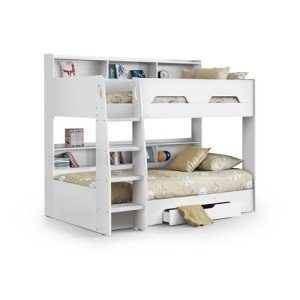Exploring Bunk Beds: A Comprehensive Guide
Bunk beds have long been a staple in children's bedrooms, dormitories, and even homes with minimal space. Not only do they offer a practical sleeping service, however they likewise create an enjoyable and creative environment for children and a great space-saver for adults and families. This article will check out everything you require to understand about bunk beds, from types and materials to security pointers and buying advice.
Table of Contents
- Types of Bunk Beds
- Conventional Bunk Beds
- Loft Beds
- Triple Bunk Beds
- L-Shaped Bunk Beds
- Material Options
- Wood
- Metal
- Safety Considerations
- Buying Guide
- FAQs
Types of Bunk Beds
Bunk beds can be found in numerous designs to match various needs and choices. Here's a breakdown of the most typical types:
Conventional Bunk Beds
Traditional bunks normally feature 2 beds stacked vertically on top of one another. These beds are perfect for siblings sharing a space or for optimizing sleeping space in visitor spaces.
Loft Beds
Loft beds stand similarly to traditional bunk beds but do not have a lower sleeping area. Rather, they often incorporate a desk or seating location below, making them a great option for small rooms needing multifunctionality.
Triple Bunk Beds
Triple bunk beds are designed for three residents, with beds stacked in a three-tier configuration. These are less typical but can be a fun service for big families or sleepovers.
L-Shaped Bunk Beds
With one bed positioned horizontally and the other vertically, L-shaped bunk beds are typically equipped with additional functions such as desks or storage drawers and can match corner areas in a room.
Comparison of Bunk Bed Types
| Bed Type | Ideal Use | Description |
|---|---|---|
| Conventional | Shared bedrooms or guest rooms | Two beds stacked vertically |
| Loft | Little spaces needing multi-purpose space | Upper bed with open space underneath |
| Triple | Large households or pajama parties | 3 beds stacked vertically |
| L-Shaped | Corner or versatile spaces | A combination of vertical and horizontal beds |
Product Options
Bunk beds are made from different products, with wood and metal being the most common. Each product has its pros and cons.
Wood
- Durability: Generally robust and can stand up to years of usage.
- Visual Appeal: Offers a traditional look that can blend with numerous designs.
- Weight Capacity: Typically tougher; can support much heavier weights.
- Disadvantages: May be more pricey than metal choices and can be susceptible to scratches.
Metal
- Toughness: Generally lightweight and easy to move however still strong.
- Modern Design: Often comes in smooth styles, making it appealing for modern spaces.
- Affordable: Usually less pricey than wooden options.
- Downsides: Can be cold to the touch in winters and might not have the very same aesthetic appeal for some purchasers.
Safety Considerations
When it pertains to bunk beds, safety can not be overlooked. Here are crucial security pointers to remember:
- Guardrails: Ensure that the top bunk has guardrails on both sides to avoid falls.
- Durable Construction: Check for a solid develop and sturdy materials to withstand weight and motion.
- Weight Limit: Adhere to the maker's weight limitation for both the upper and lower bunks.
- Ladder Design: Choose bunks with a safe, easy-to-climb ladder and prevent any sharp edges or rungs.
- Age Restrictions: Most manufacturers suggest that children under the age of 6 should not sleep in the upper bunk.
Buying Guide
When looking for bunk beds, think about the following elements to discover the best suitable for your requirements:
- Space Availability: Measure the space size and ceiling height, making sure there is sufficient space for the top bunk.
- Bed Size: Decide in between twin, full, or larger sizes based on your requirements and the size of the space.
- Style Preference: Consider the general decoration of the bed room to discover an appropriate design.
- Ease of Setup: Look for a bunk bed that is straightforward to assemble.
- Budget: Bunk beds are available in different cost varieties, so identify a budget plan before starting your search.
FAQs
1. What is the suggested age for kids to sleep on the top bunk?
Children aged 6 and older are generally recommended to sleep on the top bunk to lessen the risk of falls.
2. How can I make my bunk bed safer?
To enhance security, ensure guardrails are correctly set up and examine that the bed is positioned on a flat surface area. In addition, motivate kids to use the ladder carefully.
3. Can click over here now convert a bunk bed into 2 different beds?
Lots of bunk beds are created to be convertible. Inspect the manufacturer's requirements for convertibility functions.
4. What accessories are available for bunk beds?
Typical accessories consist of bed linens, storage drawers, staircases rather of ladders, and tented canopies for an enjoyable visual appeal.
5. How do I keep my bunk bed?
Routine look for loose screws or structural integrity can assist make sure security. Dust the bed frequently and tidy spills without delay to keep the materials in good condition.
Bunk beds are flexible and a space-efficient service for various living scenarios, from children's spaces to guest lodgings. With numerous designs and products readily available, potential purchasers have a wealth of choices to consider, ensuring a combination of usefulness and looks. By focusing on safety and following the ideas outlined in this guide, people can find the ideal bunk bed that fits their space and way of life, all while producing an enjoyable sleeping environment.

